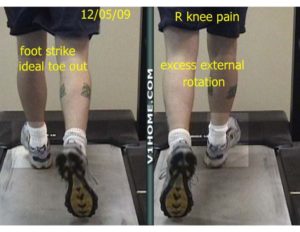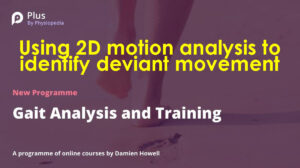Deviant Gait – Compensation

Compensation is necessary when there is injury or a necessity of making up for something unwelcome or unpleasant. Compensation can be perceived as a negative or positive situation.
With injury the dichotomy is will there be recovery or compensation? Salamanders are fascinating animals that are capable of regenerating lost limbs, as well as other damaged body parts. Salamanders repair and recover. The ability of humans to repair and recover from injury is very limited. More often than not humans the outcome of an injury is to form a scar in response to a tissue injury as opposed to regeneration or repair. We compensate to make up for the lack of repair or replacement.
A physical impairment such as a weakness, movement restriction, or sensory loss is often manifested in our abilities to walk or run. Animals have genetically hard-wired behaviors resulting in compensation for injury or physical impairments.
We have an amazing ability to automatically compensate or make up for physical impairments so that we can continue to have the ability to walk or run. We continue to move despite pain, we adapt and move around the pain problem rather than move through it. We find a way to adapt or compensate typically at joints adjacent to the injured joint. If there is a gait deviation in one joint segment such as the foot, other joints can compensates for the gait deviation.
Physical impairment leads to “gait deviations” and “gait compensations”. Gait deviations are variations from what is perceived as normal walking or running. Gait deviations are described as limitation/restriction or weakness that leads to lack of mobility, stability, or symmetry of movement. We adapt or compensate for gait deviations making biomechanical changes in the way we walk or run. These adaptations often are at the subconscious level.
A simple example is if we experience a bruise to the heel, we automatically take shorter steps; put more pressure on ball of the foot to avoid stressing the injured heel. We limp.
Paula Radcliffe world champion in marathon, half marathon, and cross country was famous for having a gait deviation best described as an awkward bobble head. Watching her run for miles during marathon race it was remarkable how her head would move. Obviously this gait deviation did not adversely affect her performance as she set the world record for running the marathon. Not every gait deviation is related to pain. Interestingly her career was troubled with several repetitive use injuries. One can wonder was the head bobbing a compensation for an under lying structural or neuro-motor impairment?
The two factors shape the automatic or subconscious gait compensation that occurs. The instinctive compensation is to move in a way that avoids pain. The instinctive compensation is to move in a way that takes the least amount of energy.
There are potential downsides to accepting the instinctive gait compensation. Compensated gait can lead to unbalance joint movements increasing risk of new pain and injury compared to gait without significant gait deviations. The instinctive gait compensation is less efficient than normal gait and can increases risk of compensatory repetitive use injury. There are situations where the instinctive compensation continues despite healing and alleviation of the original injury/pain. Accepting the default gait compensation may not always be the optimal compensation.
Healthcare providers or coaches are good at identifying gait deviations or gait compensations. However not all healthcare providers are good at answering the question of whether the default gait deviation is optimal compensation or just the easiest compensation. This is a bit more challenging and requires good clinical reasoning and problem solving.
Physical Therapists are trained in the process of gait analysis to distinguish when an observed gait deviation or unconscious gait compensation should be allowed and encouraged or consciously altered. This clinical reasoning process involves an examination using analysis of motion, systematic manipulation of potential factors which may be contributing to the observed gait deviation, and proposing working hypothesis. A working hypothesis is a suggested explanation for a group of facts or phenomena, which is proposed as a basis for further verification. Working hypothesis are “if then statements”.
An example of a working hypothesis below illustrated below the gait deviation is excessive external rotation or out toeing on the right, which is the side of the painful knee. On the left we can visualize 2 to 3 toes. On the right we can visualize 4 to 5 toes. The orientation of the left leg is normal the orientation of the right leg is deviant.

A potential working hypothesis is if the client consciously turns his leg right leg inward when running then he will experience a decrease or elimination of right knee pain.
Once the various options of gait compensations are identified than the relative benefits and also importantly, the risks or costs of the various gait compensations can be considered.
In the above example if consciously turning the leg inward eliminates knee pain but results in hip pain, this raises more questions and the need to reevaluate the original working hypothesis. Why did the runner develop this manner of running with excessive outward rotation of the right leg? Is this gait deviation because of preexisting structural asymmetry or is it acquired and potentially reversible? This demonstrates the complexity of gait analysis. This is the process of determining whether observed default gait deviation is the best or is there a better conscious gait alteration?
Identifying potential options of compensating for gait deviations is analogous to a lawyer who assists an injured individual. The lawyer identifies the pros and cons of potential compensations. A Physical Therapist can assist an individual identifying potential compensation for gait deviations and the pros and cons.
Compensation can be perceived as bad, good, or indifferent. Compensations can be easy to achieve, or difficult.
It is my understanding champion marathon Paula Radcliff used gait analysis to gain understanding of her gait deviation of head bobbling, explored other gait compensation options to alleviate the head bobbling and ultimately accepted the default head bobbing gait deviation compensation.
If your self-assessment is that you have a gait deviation and experience pain when walking or running then consider a gait analysis by a Physical Therapist with expertise in gait analysis.
A on demand-video webinar exploring this topic is available at Plus by Physiopedia entitled “Using 2D Motion Analysis to Identify Deviant Movements”.
Use this code – “Damien25” for a 30% discount to access this webinar as well as the more than 500 continuing education webinar courses available at Plus by Physiopedia. This is the link http://bit.ly/DAMIEN25 with the 30% discount code embedded.
Damien Howell Physical Therapy – 804-647-9499 – Fax: 866-879-8591 At-Home, At Office, At Fitness Facility, or Online I come to you, I do home visits Damien@damienhowellpt.com

